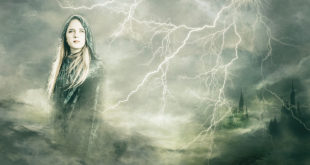iBelieve: Confidence on Judgment Day | PDF Version
TV interviewers love to challenge high-profile Christian ministers with this question: “Will so-and-so be in heaven?” The safe answer, of course, is that only God truly knows whose heart is aligned with heaven to the point where they would be safe and happy citizens in a kingdom where Jesus rules over us.
This Bible teaching must be approached with caution and humility because it grew out of a tragic blunder! In the 1840s, diligent Christians of many denominations studied the time prophecies of Daniel. They became convinced Jesus would visibly return to earth in October of 1844. Clearly He did not — lucky for those of us studying now! Those who embraced the error were sorely disappointed; many turned away from Christianity altogether. Others kept studying, pleading with the Holy Spirit to correct their mistake and renew their hope.
Slowly a new framework began to fall into place: a caring Savior and Mediator working on behalf of the human race in the heavenly sanctuary.
Earthly and Heavenly Sanctuaries
The earthly tabernacle was good news to Israel because it guaranteed God’s protective presence. Have them make a sanctuary for Me, God told Moses, and I will dwell among them (Exodus 25:8). The portable one Levite priests carried through the wilderness wandering — and later Solomon’s beautiful temple in Jerusalem — was patterned after the glorious real one in heaven itself. We do have such a High Priest [Jesus], who sat down at the right hand of the throne of the Majesty in heaven, and who serves in the sanctuary, the true tabernacle set up by the Lord, not by man (Hebrews 8:1, 2). Many of us have heard a church choir sing words taken right from Habakkuk 2:20: The Lord is in His holy temple; let all the earth keep silent before Him.
Portrait of the Salvation Process
Israel was a floundering nation of just-released slaves. They had no concept of how a coming Messiah would atone for their sins. So the wilderness sanctuary and sacrificial system were provided by the God who would send His own Son as the perfect Lamb that would take away the sins of the world (John 1:29). Everything in the wilderness was just a shadow, a fragile pencil drawing — trying to convey the real thing! Theologians call the desert rituals the “type,” while Jesus’ successful gift of His own life on the Cross was the glorious, fulfilling “antitype.”
Daily Sacrifices
Every morning and evening, sacrifices were offered on behalf of all Israel, symbolizing forgiveness and grace for the entire nation (Exodus 29:39). In addition, people confessed individual mistakes and brought sin offerings to the sanctuary. An innocent lamb would be sacrificed (type). This was a vivid reminder to the sinner that, one, sin was a deadly curse, and two, a Messiah would someday pay the true and eternal penalty (antitype). Many times a year they learned anew the reality of Hebrews 9:22: Without shedding of blood is no remission [NIV: forgiveness]. They also came to believe in the principle of substitutionary atonement: a gracious Friend dying in their stead. The sinner received forgiveness and the sin was transferred via the lamb’s blood to the sanctuary.
In terms of antitype — the whole point of this — we have heaven absorbing the cosmic accountability for our redemption. The entire gospel is summed up in the John 3:16 reality that God sent His only Son to save us. So this process of Adam’s descendants sinning . . . and confessing . . . and seeking heaven’s solution . . . has been going on for many generations now! Through Calvary, God has kindly stooped down to receive these body blows, the accumulated stains of our iniquities.
But this is not a repetitive, never-ending cycle! Sin isn’t going to keep washing up against the boundaries of the New Jerusalem. God is determined to triumph decisively against Lucifer’s pogrom of evil and wipe sin entirely out of His restored universe. Which leads us to look hopefully at the culminating phase: Yom Kippur.
The Yearly Cleansing
Once each year, the high priest would cast lot between two goats. One, representing Jesus in a grand, culminating sacrifice. This blood would actually be carried into the Most Holy Place, “behind the veil,” the sacred inner command center of God’s kingdom. Rebellion itself was symbolically addressed and atoned for by the glory of Calvary. Leviticus 16:16 says this sacrifice will make atonement for the Most Holy Place because of the uncleanness and rebellion of the Israelites.
We must meditate wisely and cautiously on this next point. Because after the sanctuary itself had been thus cleansed (Daniel 8:14), the totality of the nation’s sins were then rolled back onto the other “Azazel” goat, the remaining live one. The Adventist perspective is that in terms of blame and responsibility, this represents the final, permanent punishing of Lucifer. He will be banished forever from God’s universe. To symbolize this, the second goat was driven away into the wilderness to wander and die alone. It was eternally scorned and removed from the camp. This second goat did not bear the guilt. That would be a sacrilege beyond words. But it was cursed as a type of Satan’s ultimate blame and making the universe forever safe.
Again, these wilderness types took place repeatedly, daily — and then yearly. This, while the glorious antitype happens just once with Jesus our perfect sacrificial Lamb. Following Jesus’ victory over death, He ascended to heaven and is now our faithful High Priest. Hebrews 7:25: Therefore He is able to save completely those who come to God through Him, because He always lives to intercede for them. What’s more, converted sinners can confidently approach the throne of grace (4:16).
Judgment and a Clean Sanctuary
The Bible promises that anyone who chooses the Lamb as their Savior will not be condemned! As he or she faces judgment, a verdict of “Not Guilty” is pronounced; in fact, Jesus, our High Priest and Mediator (Matthew 10:32) is eager to be our intercessor with a heavenly Father. The Father is equally glad to accept His Son’s sacrifice as surety for our forgiveness.
Clearly, at Jesus’ second coming, when He returns with salvation rewards and a punishment of desolation for the lost (Revelation 22:12), heaven already knows the fate of every human being. Some have scorned salvation, and God reluctantly honors their choice. Many faithful believers, both living and dead, will rejoice to see their Redeemer in the clouds.
Wheat and Tares
But there are a myriad of cases not so obvious to you and me — and perhaps to sinless beings in other loyal galaxies. In all ages, the Church has been populated by both wheat and tares. There have been those who made a show of listening to God’s claims. But they never truly reached out to take the gift. Some who said yes with their mouths, but never followed up that moment with a lasting commitment of faith. There are hidden motives and secret ambitions and betrayals known only to God. It would be an act of cruelty for the Lord to imprison a hypocrite or rebel in a holy kingdom where humble worship of Jesus is the defining paradigm.
So this investigative judgment, figuratively opening up the books, is part of the culminating “Most Holy Place” process. This is when the entire roster of earth’s population — people of pure faith or rebellion — is examined. The good news is that it is a simple matter to say yes — and mean it — to the High Priest. He is eager to rescue this planet and bring each of us the reward of salvation.
Three Takeaways
These points must be affirmed as we remain solidly within the Christian framework of faith.
1) Saved Christians have full assurance during the entire salvation process. “I tell you the truth,” Jesus says, “whoever hears My word and believes Him who sent Me HAS eternal life and will not be condemned; he has passed over from death to life” (John 5:24).
2) The atonement was triumphantly achieved and completed at the Cross. “It is finished!” [Jesus] did not enter by means of the blood of goats and calves; but He entered the Most Holy Place once for all by His own blood, having obtained eternal redemption (Hebrews 9:12).
3) The moment a penitent sinner reaches out to Christ in faith, his sins are blotted out then. Repent, then, and turn to God, so that your sins may be wiped out, that times of refreshing may come from the Lord (Acts 3:19).
View related article: Heaven’s Version of Law & Order
If you liked this, you may also like The Sanctuary
© 2002 - 2025, AnswersForMe.org. All rights reserved. Click here for content usage information. Answers for Me Support & encouragement for every-day life
Answers for Me Support & encouragement for every-day life



